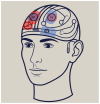Transcranial Direct Current Stimulation (tDCS) for Borderline Personality Disorder (BPD): Why and How?
- PMID: 40563719
- PMCID: PMC12191003
- DOI: 10.3390/brainsci15060547
Transcranial Direct Current Stimulation (tDCS) for Borderline Personality Disorder (BPD): Why and How?
Abstract
Background: Borderline Personality Disorder (BPD) is a severe psychiatric condition characterized by pervasive emotional dysregulation, impulsivity, and unstable interpersonal relationships. Affecting over 1% of the general population, BPD carries significant morbidity, frequent hospitalizations, and an increased risk of suicide. Although specialized psychotherapeutic approaches have shown efficacy, their impact is often constrained by availability, lengthy treatment durations, moderate effect sizes, and high dropout rates. Pharmacological treatments for BPD remain inadequate and are usually accompanied by adverse side effects.
Objective: This narrative review seeks to explore the potential of transcranial direct current stimulation (tDCS) as a safe, cost-effective, and accessible neuromodulation intervention aimed at alleviating core BPD symptoms-namely, emotional dysregulation and impulsivity-while also addressing common comorbidities and opportunities for integration with existing therapeutic modalities.
Methods: We conducted a narrative literature synthesis in accordance with the SANRA (Scale for the Assessment of Narrative Review Articles) guidelines. A PubMed/MEDLINE search was performed using keywords related to transcranial direct current stimulation (tDCS) and BPD, identifying five published randomized controlled trials on the topic. To provide a broader perspective, we also included studies from related fields examining mechanisms of action, safety and tolerability, cost-effectiveness, stimulation parameters, and clinical outcomes relevant to BPD.
Results: Conventional tDCS protocols-typically involving 1-2 mA currents for 20-30 min-have demonstrated an excellent safety profile, resulting in only minimal and transient side effects without any risk of overdose or misuse, which is a key advantage for populations at high risk of suicidality. With moderately priced devices and the feasibility of home-based administration, tDCS provides a substantially more affordable alternative to both long-term pharmacotherapy and intensive psychotherapy. Neurobiologically, tDCS modulates the excitability of the dorsolateral and ventrolateral prefrontal cortex and enhances fronto-limbic connectivity, thereby strengthening top-down regulatory control over emotion and behavior. Pilot randomized controlled trials report moderate effect sizes for improvements in emotional regulation, inhibitory control, and rejection sensitivity, along with ancillary gains in executive functioning and reductions in depressive and substance-use symptoms when stimulating the left dorsolateral prefrontal cortex.
Conclusions: tDCS stimulation emerges as a safe and scalable adjunctive treatment for BPD, leveraging targeted neuromodulation to address core features and common comorbidities like depression. However, variability in current protocols and the scarcity of well-powered randomized trials underscore the pressing need for standardized methodologies, longer-term follow-up, and individualized stimulation strategies to establish enduring clinical benefits.
Keywords: borderline personality disorder; emotional dysregulation; impulsivity; tDCS.
Conflict of interest statement
The authors declare no conflicts of interest.
Figures

References
-
- American Psychiatric Association . Diagnostic and Statistical Manual of Mental Disorders. 5th ed. American Psychiatric Publishing; Washington, DC, USA: 2022.
Publication types
LinkOut - more resources
Full Text Sources

